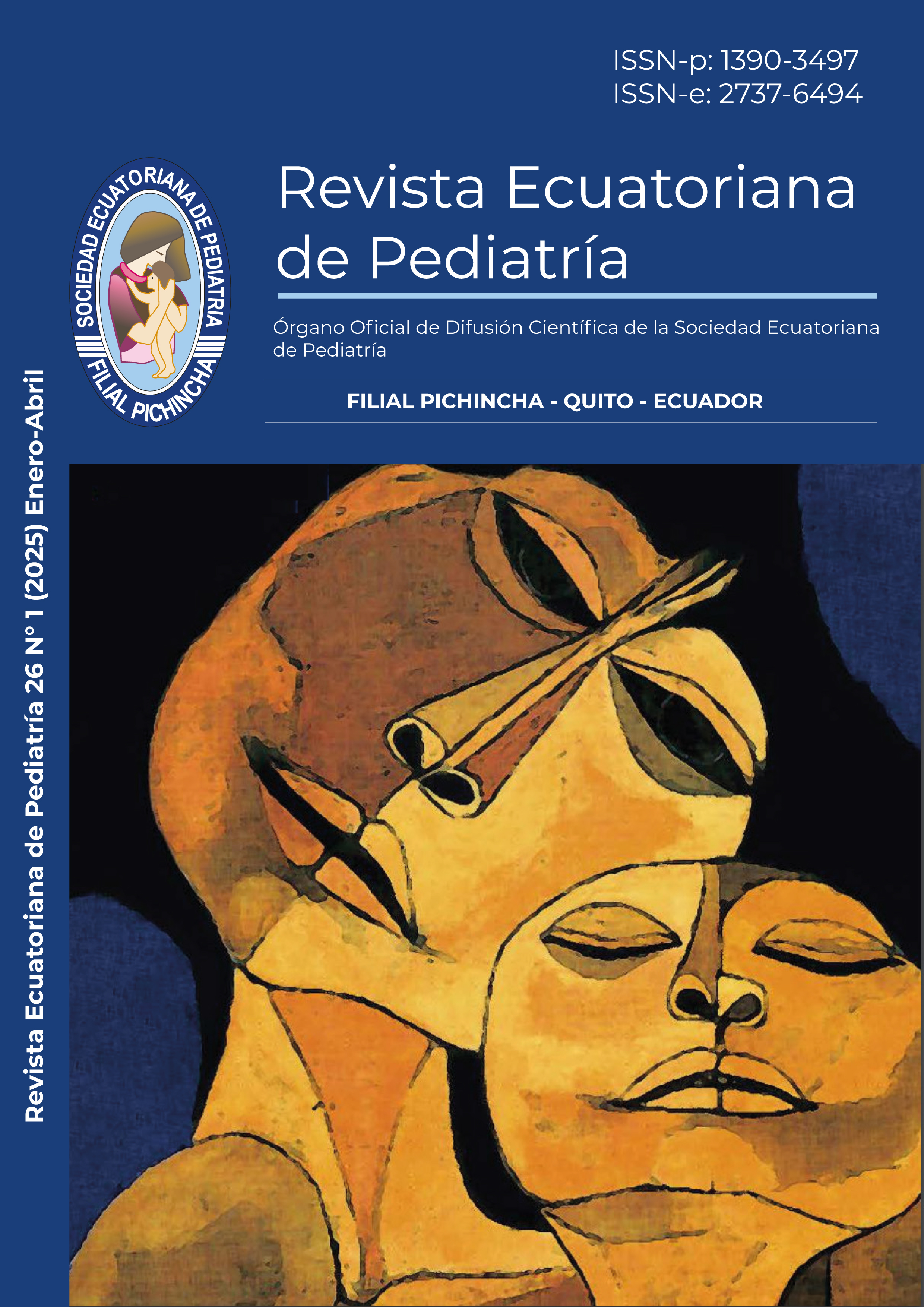EOSINOPHILIC PUSTULOUS FOLLICULITIS OF CHILDHOOD AN UNCOMMON DERMATOSIS IN PEDIATRICS!
Main Article Content
Abstract
Eosinophilic pustular folliculitis of infancy is a sterile inflammatory dermatosis that generally affects children under 36 months of age. It is considered a self-limiting disease and typically resolves spontaneously by 3 years of age in most patients 1. Although its pathophysiological mechanism is unclear, it is thought to be caused by an antigenic stimulus that leads to a deregulation of the immune mechanisms and a localized hypersensitivity reaction, with selective chemotaxis of eosinophils 2. It is characterized by recurring papules, pruritic sterile pustules, primarily located on the scalp and may also affect the trunk and extremities.
Although its diagnosis is clinical, it can be confirmed through histopathological examination, which reveals a mixed inflammatory infiltrate in the dermis, consisting of neutrophils with a predominance of eosinophils at the follicular and perifollicular level, which is a common characteristic associated with peripheral eosinophilia 3. Currently, antihistamines represent the first line of treatment due to their anti-eosinophilic effect, as well as corticosteroids, calcineurin inhibitors and certain NSAIDs such as indomethacin 4.
This study presents the clinical case of a 1-year-and-3-month-old infant with a dermatosis located on the scalp characterized by some erythematous papules, scabs, pustules, and whitish scales. These symptoms had been developing for 6 months, were associated with itching, and were initially treated as scabies. The relevance of this article lies in the importance of recognizing this pathology to avoid erroneous diagnoses and prescriptions.
Downloads
Article Details

This work is licensed under a Creative Commons Attribution-NonCommercial-ShareAlike 4.0 International License.
References
Fertitta L, Bodemer C, Molina T, Frassati-Biaggi A, Fraitag S, Leclerc-Mercier S. Eosinophilic Pustular Folliculitis of Infancy: A Histologic Assessment of 43 Cases. Pubmed [Internet]. el 1 de junio de 2022; Disponible en: https://pubmed.ncbi.nlm.nih.gov/35583404/
Yoshida S, Yatsuzuka K, Chigyo K, Kuroo Y, Takemoto K, Sayama K. A Case of Eosinophilic Pustular Folliculitis since Birth. Pubmed [Internet]. el 8 de enero de 2021; Disponible en: http://dx.doi.org/10.3390/children8010030
García-Patos V, Pujol RM, De Moragas JM. Infantile Eosinophilic Pustular Folliculitis. Clinical and Laboratory Investigations. 1994;133–8.
Odyakmaz Demirsoy E, Demirsoy U, Ozod U, Kiran R. Eosinophilic pustular folliculitis of infancy suppressed with cetirizine. Pubmed [Internet]. mayo de 2019; Disponible en: https://pubmed.ncbi.nlm.nih.gov/30791150/
Morales A, Matheu R, González Y, Yanguasb J, Caballero M, Torio B, et al. Pustulosis eosinofílica infantil [Internet]. Academia Española de Dermatología y Venereología; 2024. Disponible en: https://www.actasdermo.org/es-pustulosis-eosinofilica-infantil-articulo-13071108
Luelmo Aguilar J, Sáez Artacho A. Foliculitis pustulosa eosinofílica en el lactante. Anales Españoles de Pediatría; 2001.
Nomura T, Katoh M, Yamamoto Y, Miyachi Y, Kabashima K. Eosinophilic pustular folliculitis: A proposal of diagnostic and therapeutic algorithms. Pubmed. noviembre de 2016;1301–6.
Takei S, Hayashi R, Tomii K, Deguchi T, Fujikawa H, Shinkuma S, et al. Two cases of infancy associated eosinophilic pustular folliculitis (I-EPF) comparing the profile of infiltrating cells with classic EPF by immunohistochemical study. Pubmed. enero de 2024;125–9.
Guo W, Qian G, Zhang C. Eosinophilic pustular folliculitis of infancy. National library of med. julio de 2023;429.
Hernández-Martín Á, Nuño-González A, Colmenero I, Torrelo A. Eosinophilic pustular folliculitis of infancy: A series of 15 cases and review of the literature. Journal of the american academy of derma. el 7 de otoño de 2013;68:150–5.
Duarte A, Kramer J, Yusk J, Paller A, Schachner L. Eosinophilic Pustular Folliculitis in Infancy and Childhood. University of California - San Diego. febrero de 1993;
Mathes E, Kittler N. Vesicular, pustular, and bullous lesions in the newborn and infant. Uptodate [Internet]. el 22 de enero de 2024; Disponible en: https://www-uptodate-com.bibliotecavirtual.udla.edu.ec/contents/vesicular-pustular-and-bullous-lesions-in-the-newborn-and-infant
Saylam Kurtipek G, Zekey E, Tuncez Akyurek F, Demirbas A, Harmankaya İ. Infantile Eosinophilic Pustular Folliculitis: A Case Report. National library of medicin. marzo de 2022;1143–6.
Hyun Lee J, Hee Kang J, Kee Cho B, Jeong Park H. Generalized Eosinophilic Pustular Folliculitis of Infancy Responding to Hydroxyzine. National Library of Medicine. agosto de 2015;458–60.
Buckley D, Munn S, Higgins E. Neonatal eosinophilic pustular folliculitis. National library of medici. mayo de 2001;251–5.
Giard F, Marcoux D, McCuaig C, Powell J, Russo P. Eosinophilic pustular folliculitis (Ofuji disease) in childhood: a review of four cases. National library of medicine. septiembre de 1991;189–93.
Frølunde AS, Braae Olesen A, Riber-Hansen R, Uldall Pallesen K. Eosinophilic pustular folliculitis of infancy: A rare diagnosis in children. National library of medicine [Internet]. mayo de 2021; Disponible en: http://dx.doi.org/10.1002/ccr3.4167
Solomon D. NSAIDs (including aspirin): Pharmacology and mechanism of action. Pubmed [Internet]. el 11 de junio de 2024; Disponible en: https://www-uptodate-com.bibliotecavirtual.udla.edu.ec/contents/nsaids-including-aspirin-pharmacology-and-mechanism-of-action?search=indometacina&source=search_result&selectedTitle=8%7E150&usage_type=default&display_rank=7
Harris D, Ostlere L, Buckley C, Johnson M, Rustin M. Eosinophilic pustular folliculitis in an HIV-positive man: response to cetirizine. National library of medicine. abril de 1992;392–4.

